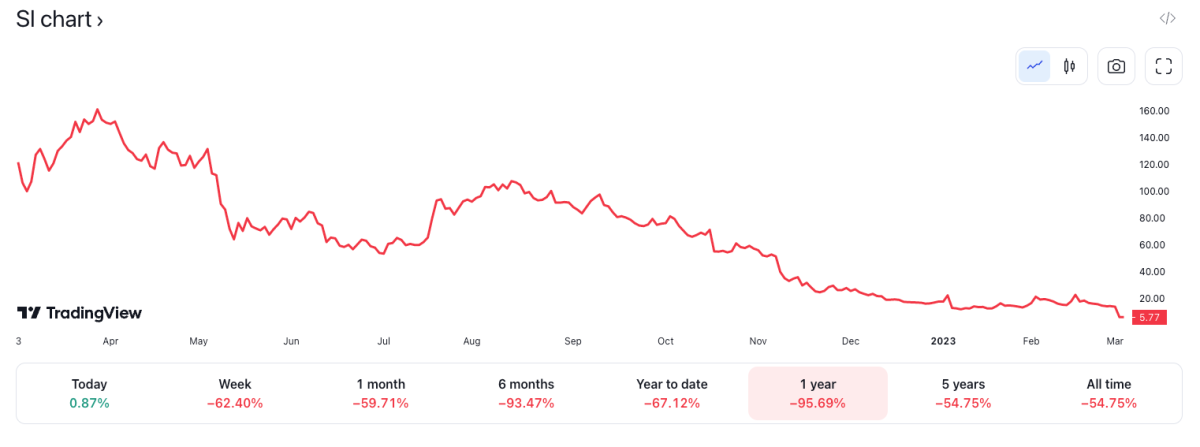Crypto markets have been rallying hard since the beginning of this year. The two largest crypto assets, Bitcoin (BTC) and Ethereum (ETH) are both up 35% and 31% respectively, year-to-date. This rally has seen more than US$100 billion added to the total crypto market since January 1, leading many investors to believe that a crypto ‘bull market’ might be back on the cards.
However, a recent drop in crypto prices has thrown these bullish convictions under the spotlight, with many analysts and market participants now fearing that a larger downturn may be waiting just around the corner.
Over the last two weeks, the price of Bitcoin has fallen a little more than 10% while the price of Ethereum has dropped 9%. Currently, Bitcoin is trading for US$23,456 apiece while Ethereum is changing hands for US$1,567.
Why is Bitcoin falling down today?
There are a number of reasons for the recent plunge in crypto prices, with the most recent issue being industry-wide concerns directed at a crypto-friendly bank called Silvergate Capital (NYSE:SI).
On Friday last week, a number of major crypto firms rushed to publicly distance themselves from Silvergate after the financial institution delayed the release of its annual 10-K report, which signalled to investors from both crypto and traditional finance that the institution may be in serious financial distress.
In response to the delayed notice, the price of Silvergate Capital’s stock has since plummeted more than 55%, falling from US $13.91 a share to US$5.77 at current. Silvergate’s share price is currently down a staggering 93% from its all-time-high of US$222, which was reached in November 2021 during the last major crypto market rally.

This has led many to conclude that Silvergate is on the verge of collapse, with Marc Cohodes, a notorious short-seller (an investor who routinely bets on prices going down) sharing that he would be “surprised if the bank was open next week.”
Similarly, venture capitalist and partner at Cinneamhain Ventures Adam Cochran took to Twitter to inform his 183,000 followers that the bank was in fact on a “death spiral” which would have sweeping negative effects for crypto markets.
Following the collapse of the crypto exchange FTX in November last year, investors withdrew more than US$8 billion from Silvergate. Additionally, Silvergate is also being probed by the US Department of Justice over its links to potential fraud with the now-defunct FTX and the exchange’s sister hedge fund Alameda Research.
The Federal Reserve may want to ‘hike’ rates again
While Silvergate is arguably the main catalyst for crypto’s current downward spiral, there are number of other macro effects at play, that are adding weight to the ‘sell’ side of crypto markets.
Analysts are predicting that the US Federal Reserve will increase interest rates later this month at the Federal Open Market Committee on March 21 to further combat inflation.
In conversation with The Chainsaw, eToro’s Australian market analyst Josh Gilbert said that the expectations of further rate hikes are indeed having a considerable effect on current crypto price movements. Typically when the Federal Reserve raises interest rates, investors look to take their money out of risky assets like cryptocurrencies and growth stocks.
“Even though we’re still well above the lows that crypto assets experienced in 2022, the market is at the mercy of incoming macro data, particularly from the US,” said Gilbert. “Inflation isn’t quite cooling to the extent that the reserve banks like the Fed want to see, which means they won’t be able to take their foot off the gas just yet when it comes to cash rates.”
“This broader rally that we’ve just seen is likely to lose some steam throughout March, with sticky inflation and higher rate expectations likely to dampen investor sentiment,” Gilbert added.
Whenever the US Federal Reserve hikes interest rates, investors typically seek access to assets like bonds which pay higher yields as interest rates go up.
Essentially, every time the Fed hikes rates, investors have less incentive to hold their money in risky assets. As a result, an expectation of continued rate hikes tends to cause gradual selling activity, driving the price of crypto assets like Bitcoin and Ethereum downwards.
Crypto market down: US regulators are cracking down on crypto
Adding further to the downward pressure in prices are the recent moves from regulators in the US. Both the New York Department of Financial Services (NYDFS) and the SEC have come down hard on a number of major cryptocurrency firms in the US over the course of the last month.
At the beginning of February, the SEC fined the US-based crypto exchange Kraken US$30 million and ordered it to shut down its ‘staking as a service’ products for American clients. This caused wider fears that the regulator may soon look to ban the practice of crypto ‘staking’ in its entirety, a move that would have potentially disastrous effects for the wider market.
Days later, the NYDFS ordered a company called Paxos to stop issuing Binance’s US Dollar-pegged stablecoin, ‘BUSD’. Immediately following this, the SEC announced it would be launching legal action against Paxos, as it deemed that the BUSD stablecoin is in fact, an unregistered security.





